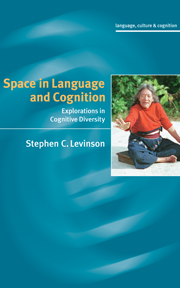Crossref Citations
This Book has been
cited by the following publications. This list is generated based on data provided by Crossref.
2003.
Books Received.
Current Anthropology,
Vol. 44,
Issue. 5,
p.
748.
Mishra, Ramesh C.
Dasen, Pierre R.
and
Niraula, Shanta
2003.
Ecology, language, and performance on spatial cognitive tasks.
International Journal of Psychology,
Vol. 38,
Issue. 6,
p.
366.
Bennardo, Giovanni
and
Schultz, Kurt
2004.
Three Innovative Research Tools to Store, Visualize, and Analyze Data in and from the Field.
Field Methods,
Vol. 16,
Issue. 4,
p.
396.
Thrift, Nigel
2004.
Movement-space: The changing domain of thinking resulting from the development of new kinds of spatial awareness.
Economy and Society,
Vol. 33,
Issue. 4,
p.
582.
Thrift, Nigel
2004.
Thick Time.
Organization,
Vol. 11,
Issue. 6,
p.
873.
Niraula, Shanta
Mishra, Ramesh C.
and
Dasen, Pierre R.
2004.
Linguistic Relativity and Spatial Concept Development in Nepal.
Psychology and Developing Societies,
Vol. 16,
Issue. 2,
p.
99.
Duranti, Alessandro
2005.
On theories and models.
Discourse Studies,
Vol. 7,
Issue. 4-5,
p.
409.
Janzen, Gabriele
and
Hawlik, Michaela
2005.
Orientierung im Raum.
Zeitschrift für Psychologie / Journal of Psychology,
Vol. 213,
Issue. 4,
p.
179.
Odlin, Terence
2005.
CROSSLINGUISTIC INFLUENCE AND CONCEPTUAL TRANSFER: WHAT ARE THE CONCEPTS?.
Annual Review of Applied Linguistics,
Vol. 25,
Issue. ,
p.
3.
Levinson, Stephen C.
2005.
Living with Manny's dangerous idea.
Discourse Studies,
Vol. 7,
Issue. 4-5,
p.
431.
Kleiner, Luna Filipovic
2005.
The Semantics of English Prepositions.
Journal of Pragmatics,
Vol. 37,
Issue. 5,
p.
775.
Bezuidenhout, Anne
2005.
Indexicals and Perspectivals.
Facta Philosophica,
Vol. 7,
Issue. 1,
p.
3.
Alibali, Martha W.
2005.
Gesture in Spatial Cognition: Expressing, Communicating, and Thinking About Spatial Information.
Spatial Cognition & Computation,
Vol. 5,
Issue. 4,
p.
307.
Enfield, N. J.
2005.
The Body as a Cognitive Artifact in Kinship Representations.
Current Anthropology,
Vol. 46,
Issue. 1,
p.
51.
Coventry, Kenny R.
and
Frias-Lindqvist, Anne M.
2005.
The Influence of Movement, Alignment and Orientation on the Comprehension of Spatial Adpositions in English and Finnish.
Spatial Cognition & Computation,
Vol. 5,
Issue. 4,
p.
357.
Tenbrink, Thora
2005.
Spatial Cognition IV. Reasoning, Action, Interaction.
Vol. 3343,
Issue. ,
p.
124.
De Mulder, Walter
2006.
Carina Andersson.Equivalence et saillance dans l'expression de la localisation frontale dynamique en suédois et en français. Etude comparative et contrastive deframet de(s')avancer/en avant. (Thèse de doctorat, Université d'Uppsala.) Universitetstryckeriet. Uppsala 2004..
Studia Neophilologica,
Vol. 78,
Issue. 2,
p.
216.
Gibson, Bradley S.
and
Kingstone, Alan
2006.
Visual Attention and the Semantics of Space.
Psychological Science,
Vol. 17,
Issue. 7,
p.
622.
Pupier, Paul
2006.
Laurence R. Horn et Gregory Ward, eds. The handbook of pragmatics. Oxford : Blackwell, 2004. Pp. xix + 842. 157,95$US (relié)..
Canadian Journal of Linguistics/Revue canadienne de linguistique,
Vol. 51,
Issue. 1,
p.
85.
Núñez, Rafael E.
and
Sweetser, Eve
2006.
With the Future Behind Them: Convergent Evidence From Aymara Language and Gesture in the Crosslinguistic Comparison of Spatial Construals of Time.
Cognitive Science,
Vol. 30,
Issue. 3,
p.
401.



